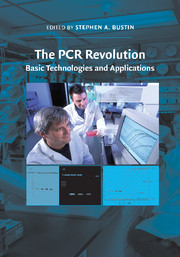Book contents
- Frontmatter
- Contents
- Contributors
- Foreword by Russell Higuchi
- Preface
- I BASIC TECHNOLOGIES
- 1 Real-time polymerase chain reaction
- 2 Thermostable enzymes used in polymerase chain reaction
- 3 Inventing molecular beacons
- 4 Rapid polymerase chain reaction and melting analysis
- 5 Polymerase chain reaction and fluorescence chemistries: deoxyribonucleic acid incarnate
- 6 Analysis of microribonucleic acid expression by quantitative real-time polymerase chain reaction
- 7 Miniaturized polymerase chain reaction for quantitative clinical diagnostics
- 8 The road from qualitative to quantitative assay: What is next?
- 9 Taking control of the polymerase chain reaction
- II APPLICATIONS
- Index
- Plate section
- References
4 - Rapid polymerase chain reaction and melting analysis
Published online by Cambridge University Press: 25 January 2011
- Frontmatter
- Contents
- Contributors
- Foreword by Russell Higuchi
- Preface
- I BASIC TECHNOLOGIES
- 1 Real-time polymerase chain reaction
- 2 Thermostable enzymes used in polymerase chain reaction
- 3 Inventing molecular beacons
- 4 Rapid polymerase chain reaction and melting analysis
- 5 Polymerase chain reaction and fluorescence chemistries: deoxyribonucleic acid incarnate
- 6 Analysis of microribonucleic acid expression by quantitative real-time polymerase chain reaction
- 7 Miniaturized polymerase chain reaction for quantitative clinical diagnostics
- 8 The road from qualitative to quantitative assay: What is next?
- 9 Taking control of the polymerase chain reaction
- II APPLICATIONS
- Index
- Plate section
- References
Summary
The polymerase chain reaction (PCR) is conceptually divided into three reactions, each usually assumed to occur over time at a single temperature. Such an “equilibrium paradigm” of PCR is naïve, but widely accepted. It is easy to think of three reactions (denaturation, annealing, and extension) occurring at three temperatures over three time periods in each cycle (Figure 4–1, left). However, this equilibrium paradigm does not fit well with physical reality. Instantaneous temperature changes do not occur; it takes time to change the sample temperature. Furthermore, individual reaction rates vary with temperature, and after primer annealing occurs, polymerase extension immediately follows. More accurate is a kinetic paradigm for PCR in which reaction rates and the temperature are always changing (Figure 4–1, right). Holding the temperature constant during PCR is not necessary as long as the products denature and the primers anneal. Under the kinetic paradigm of PCR, product denaturation, primer annealing, and polymerase extension may temporally overlap and their rates continuously vary with temperature. Under the equilibrium paradigm, three temperatures each held for finite time periods define a cycle, whereas the kinetic paradigm requires transition rates and target temperatures.
Paradigms are not right or wrong, but should be judged by their usefulness. The equilibrium paradigm is simple to understand and lends itself well to the engineering mindset and instrument manufacturing. The kinetic paradigm is more relevant to biochemistry, rapid PCR, and melting curve analysis.
- Type
- Chapter
- Information
- The PCR RevolutionBasic Technologies and Applications, pp. 48 - 69Publisher: Cambridge University PressPrint publication year: 2009
References
- 1
- Cited by



